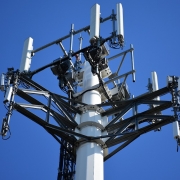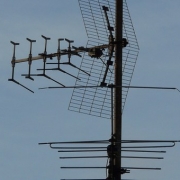Antenna Parameter Measurement
4-170GHz millimeter wave solution (E-band, W-band) High-performance 3672 series vector network analyzer! RF PXI switch up to 65GHz
The antenna parameter is an amount describing the characteristics of the antenna and can be determined experimentally. The measurement of antenna parameters (referred to as antenna measurement) is an important means of designing antennas and adjusting antennas. Because the characteristics of the antenna are multi-faceted, an antenna has many parameters (see antenna characteristic parameters, antenna directivity, antenna impedance). Among these parameters, the most important thing to measure is the pattern, input impedance and gain.
Measurement of Antenna Patterns Figure 1 is one of the schemes for measuring patterns in the planes through the phase center of the antenna. In the figure, the antenna 1 is the antenna to be tested, and is connected to the signal generator for transmission. It is mounted on the rotating platform for 360° rotation; the antenna 2 is an auxiliary antenna, which is connected with the electric field intensity meter to measure the antenna to be measured. The field strength at the distance. The polarization characteristics of the two antennas are the same. In order to approximate the far field conditions, the distance between the two antennas should be satisfied.
Where λ is the test operating wavelength; the meaning of r and D is shown in Figure 1. When the antenna 1 to be measured is rotated, the electric field intensity E(θ) of the function represented by the rotation angle θ can be measured at the antenna 2, so that the pattern of the antenna 1 in the plane of rotation can be drawn. If the antenna under test is a half-wave antenna, its orientation in the meridional plane is shown in Figure 2a. When the antenna is rotated 90° to make it perpendicular to the plane of rotation, the pattern in the equatorial plane can be measured (Fig. 2b). If the antenna is installed at an arbitrary angle, the pattern in any plane can be measured. In addition, the antenna 1 to be tested can also be fixed, and the auxiliary antenna 2 can be measured along the circular motion centered on the antenna to be measured and the distance r is a radius, and the antenna pattern can also be measured. If the transmission and reception conditions are interchanged, that is, the antenna to be measured is used for reception, and the auxiliary antenna is used for transmission, the final measured antenna pattern does not change, which is in accordance with the antenna reciprocity theorem..png)
Antenna Input Impedance Measurement The antenna input impedance is the impedance seen from the input of the antenna to the antenna. In principle, all methods of measuring impedance can be used to measure the input impedance of the antenna. But in fact, the commonly used methods are the bridge method and the measurement line method. The former is often used for shortwaves, and the latter is often used for antennas above ultrashort waves.
The bridge method measurement of the antenna input impedance is shown in Figure 3. The signal generator in the figure produces a voltage of the desired frequency, which is applied to one diagonal of the bridge, and a high frequency microvolt voltmeter is used as a balance indicator on the other diagonal. The bridge consists of four impedances, where Z1 and Z2 are fixed impedances, Z3 is a variable impedance, and Zx is the input impedance of the antenna under test, ie the input of the antenna acts as an arm of the bridge. Adjusting the variable impedance makes the balance indicator read to zero, indicating that the bridge has reached equilibrium and can be calculated according to the bridge balance conditions.
The input impedance of the antenna can be measured by the measurement line method as shown in FIG. The measurement line in the figure is a transmission line with a movable field strength indicator (length should be greater than half wavelength). One end of the measurement line is connected to the signal generator, the generator is adjusted to the required frequency, and the other end of the measurement line is connected. Measuring antenna. By measuring the voltage (electric field) distribution along the measurement line (Fig. 4), the input impedance Zx of the antenna under test can be calculated by the following equation.
Where ZC is the characteristic impedance of the measuring line; K is the traveling wave system, λ is the working wavelength; z0 is the distance from the first voltage node to the measured impedance connection point.
When measuring impedance with the measuring line method, calculating the impedance value to be measured based on the measured data is a time-consuming task, especially since the input impedance of the antenna varies with the operating frequency, so when it is necessary to measure the antenna at a plurality of frequency points When the input impedance is increased, the workload will increase greatly. However, if the circular map is used to calculate the impedance to be measured or the automatic sweep impedance meter is used, the workload of measuring the input impedance of the antenna can be greatly reduced.
Measurement of Antenna Gain Coefficients Antenna gain factor measurements are commonly used in absolute and comparative methods. The gain factor of the antenna can be measured by an absolute method as shown in FIG. First, the input power of the antenna to be tested and the electric field strength at a sufficient distance r are respectively measured by a power meter and a field strength meter, and then the gain coefficient of the antenna is obtained by the following formula:
or
Where E is the electric field strength at the maximum radiation direction at distance r; P is the input power.
The gain factor of the antenna can be measured by a comparison method as shown in FIG. The output of the signal generator is first connected to the antenna under test via the matcher. At this time, the field strength meter measures the electric field strength at the distance r as E1; then replaces the antenna under test with a standard antenna with a known gain of G’ times, and The matching is adjusted, and the electric field strength measured by the field strength meter is E2. Then use the following formula to calculate the gain coefficient G of the antenna under test:
or
Analog Measurements Measurement of antenna parameters in the laboratory requires the antenna to be tested to have a “suitable” size. The size of the practical antenna is very large, up to several hundred meters, and only a few millimeters. For ease of measurement, the reduced or enlarged model can be measured at the appropriate frequency. At this point, the model antenna needs to be designed so that its parameters are the same as those of the actual antenna. This is the analog measurement of the antenna.
Under free space conditions, a model antenna with a linearity factor of Kd is produced (ie, the size of the model antenna is equal to the size of the actual antenna divided by Kd), and the following conditions should be met during the measurement: operating frequency f2=Kd·f1, model antenna The conductivity σ2 = Kd · σ1, where f1 and σ1 represent the operating frequency and conductivity of the actual antenna.
In the actual measurement of the antenna, the first condition can only be satisfied, but the second condition cannot be met, but this does not introduce too much error for most high-efficiency antennas.
Near-field measurement For large-diameter antennas for applications such as radio astronomy and radar equipment, it is difficult to meet the minimum distance required for measurement. Such as antenna diameter 100 meters, working wavelength 10 cm, test distance
Such a large test site is virtually impossible to do. Also due to the influence of the curvature of the Earth’s surface, in order to prevent electromagnetic waves from being obscured by the spherical earth’s surface, the height of the transmitting and receiving antennas will also reach an unrealistic level. For such large antennas, there are usually two methods for measuring the parameters, namely, the measurement technique using the radio star and the near-field measurement technique.
The radio star measurement technology uses a radiation-stable radio star as a transmission source, and the antenna under test is used for reception. This ensures that the distance between the transceivers is much larger than the minimum test distance.
The near field measurement technique measures the antenna parameters of the far zone near the antenna (within a distance of only a few focal lengths from the antenna surface). Near field measurement techniques include the telemetry method, the focusing method, and the extrapolation analysis method.
1 Telemetry: Using a specific signal transmitting antenna to reduce the distance between the transmitting and receiving antennas, it can still ensure that the transmitting antenna produces the same plane wave as the long distance at the receiving antenna aperture. A typical transmitting antenna produces a spherical wave in its vicinity. In order to correct the spherical wave to a plane wave, an additional lens or a parabolic reflector or the like can be used.
2 Focus method: adjust the antenna to be measured, such as parabolic reflector antenna, lens antenna, phased array antenna and other antennas with focusing characteristics, the original focus on infinity is changed to focus on the near field (several focal length or several Within ten distances of the wavelength), then the pattern is measured in the focal zone. The method of focusing the antenna in the near field region is: the parabolic reflector antenna can move the feed from the focus out of the axis for a short distance; the lens antenna can be installed in a range of focal length to two focal lengths; The phased array antenna can be achieved by appropriately adjusting its phase shifter.
3 Extrapolation analysis method: firstly measure the field distribution on the antenna aperture or the current distribution on the surface of the antenna conductor, and then use the analytical method to calculate the far field distribution, that is, the far-field pattern of the antenna.
When the microwave darkroom is used to measure the antenna parameters in an ordinary laboratory, the surrounding environment causes reflection, scattering, and diffraction of electromagnetic waves. The “interference” of the reflection, scattering, and diffraction fields on the measurement field leads to a decrease in measurement accuracy. The impact on the zero-depth depth of the pattern and the measurement of weak fields such as side lobes is particularly serious. The establishment of a microwave darkroom can solve this problem. The microwave darkroom is the laboratory in which microwave absorbing materials are installed. The darkroom is used not only for antenna measurements, but also for the measurement of weak field strengths such as the target scattering field and the diffraction field. The use of a darkroom can reduce the interference field and thus improve the measurement accuracy, and also ensure a confidential, all-weather measurement environment. Since the establishment of the first microwave darkroom in 1953, the technical specifications of the darkroom have been greatly improved.
Initially, the darkroom uses a flat-plate type of absorbent material that has a narrower absorption band. Modern broadband microwave darkrooms mostly use tapered or wedge shaped absorbent materials. A well-designed microwave darkroom with interference fields below -40 dB in the measurement zone.
From:http://www.hj-antenna.com/antenna-parameter-measurement/









Leave a Reply
Want to join the discussion?Feel free to contribute!